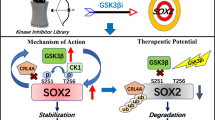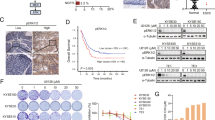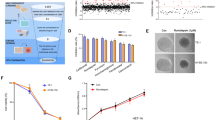Abstract
The mortality rate of esophageal squamous cell carcinoma (ESCC) is higher than that of other cancers worldwide owing to a lack of therapeutic targets and related drugs. This study aimed to find new drugs by targeting an efficacious therapeutic target in ESCC patients. Signal transducer and activator of transcription 3 (STAT3) is hyperactive in ESCC. Herein, we identified a novel STAT3 inhibitor, periplogenin, which strongly inhibited phosphorylation of STAT3 at Tyr705. Docking models and pull-down assays revealed that periplogenin bound directly and specifically to STAT3, leading to significant suppression of subsequent dimerization, nuclear import, and transcription activities. In addition, STAT3 knockdown cell lines were insensitive to periplogenin, whereas in contrast, STAT3-overexpressing cells were more sensitive to periplogenin, indicating that STAT3 was a target of periplogenin. Intraperitoneally administered periplogenin exhibited efficacious therapeutic effects in ESCC patient-derived xenograft models and dramatically impaired the phosphorylation of STAT3 and expression levels of STAT3-mediated downstream genes. Thus, our study demonstrated that periplogenin acted as a new STAT3 inhibitor, suppressing the growth of ESCC in vitro and in vivo, providing a basis for its potential application in ESCC treatment and prevention.
This is a preview of subscription content, access via your institution
Access options
Subscribe to this journal
Receive 50 print issues and online access
$259.00 per year
only $5.18 per issue
Buy this article
- Purchase on Springer Link
- Instant access to full article PDF
Prices may be subject to local taxes which are calculated during checkout







Similar content being viewed by others

References
Bray F, Ferlay J, Soerjomataram I, Siegel RL, Torre LA, Jemal A. Global cancer statistics 2018: GLOBOCAN estimates of incidence and mortality worldwide for 36 cancers in 185 countries. CA: a cancer J clinicians. 2018;68:394–424.
Song Y, Li L, Ou Y, Gao Z, Li E, Li X, et al. Identification of genomic alterations in oesophageal squamous cell cancer. Nature. 2014;509:91–95.
Pennathur A, Gibson MK, Jobe BA, Luketich JD. Oesophageal carcinoma. Lancet. 2013;381:400–12.
Smyth EC, Lagergren J, Fitzgerald RC, Lordick F, Shah MA, Lagergren P, et al. Oesophageal cancer. Nat Rev Dis Prim. 2017;3:17048.
Khazaei S, Soheylizad M, Veisani Y, Rezaeian S, Biderafsh A, et al. Global inequality in the incidence and mortality rates of esophageal cancer: a country-level analysis. Int J Cancer Manag. 2018;11:e10059.
Pan R, Zhu M, Yu C, Lv J, Guo Y, Bian Z, et al. Cancer incidence and mortality: a cohort study in China, 2008-2013. Int J Cancer. 2017;141:1315–23.
Chen W, Zheng R, Baade PD, Zhang S, Zeng H, Bray F, et al. Cancer statistics in China, 2015. CA: a cancer J clinicians. 2016;66:115–32.
van Rossum PSN, Mohammad NH, Vleggaar FP, van Hillegersberg R. Treatment for unresectable or metastatic oesophageal cancer: current evidence and trends. Nat Rev Gastroenterol & Hepatol. 2018;15:235–49.
Okines A, Sharma B, Cunningham D. Perioperative management of esophageal cancer. Nat Rev Clin Oncol. 2010;7:231–8.
Kato K, Muro K, Ando N, Nishimaki T, Ohtsu A, Aogi K, et al. A phase II study of nedaplatin and 5-fluorouracil in metastatic squamous cell carcinoma of the esophagus: The Japan Clinical Oncology Group (JCOG) Trial (JCOG 9905-DI). Esophagus. 2014;11:183–8.
Huynh J, Chand A, Gough D, Ernst M. Therapeutically exploiting STAT3 activity in cancer - using tissue repair as a road map. Nat Rev Cancer. 2019;19:82–96.
Yu H. STATs in cancer inflammantation and immunity: a leading role for STAT3. Natrevcancer. 2009;9:798–809.
Yu H, Jove R. The STATs of cancer — new molecular targets come of age. Nat Rev Cancer. 2004;4:97–105.
Johnson DE, O'Keefe RA, Grandis JR. Targeting the IL-6/JAK/STAT3 signalling axis in cancer. Nat rev Clin oncol. 2018;15:234–48.
Banerjee K, Resat H. Constitutive activation of STAT3 in breast cancer cells: a review. Int J Cancer. 2016;138:2570–8.
Becker S, Groner B, Muller C. Three-dimensional structure of the Stat3beta homodimer bound to DNA. Nature. 1998;394:P.145–151.
Zhong Z, Wen Z, Darnell JE Jr. Stat3: a STAT family member activated by tyrosine phosphorylation in response to epidermal growth factor and interleukin-6. Science. 1994;264:95–98.
Bai L, Zhou H, Xu R, Zhao Y, Chinnaswamy K, McEachern D, et al. A potent and selective small-molecule degrader of STAT3 achieves complete tumor regression in vivo. Cancer Cell. 2019;36:498–511.e417.
Liu L, McBride KM, Reich NC. STAT3 nuclear import is independent of tyrosine phosphorylation and mediated by importin-alpha3. Proc Natl Acad Sci USA. 2005;102:8150–5.
Darnell Jr JE. STATs and gene regulation. Science. 1997;277:1630–5.
Levy DE, Darnell Jr JE. Signalling: Stats: transcriptional control and biological impact. Nat Rev Mol Cell Biol. 2002;3:651–62.
Yu H, Lee H, Herrmann A, Buettner R, Jove R. Revisiting STAT3 signalling in cancer: new and unexpected biological functions. Nat Rev Cancer. 2014;14:736–46.
Horiguchi A, Asano T, Kuroda K, Sato A, Asakuma J, Ito K, et al. STAT3 inhibitor WP1066 as a novel therapeutic agent for renal cell carcinoma. Br J cancer. 2010;102:1592–9.
Hussain SF, Kong LY, Jordan J, Conrad C, Madden T, Fokt I, et al. A novel small molecule inhibitor of signal transducers and activators of transcription 3 reverses immune tolerance in malignant glioma patients. Cancer Res. 2007;67:9630–6.
Shin-Yi C, Chen YH, Lin PR, Chao TC, Su JC, Chung-Wai S, et al. Two novel SHP-1 agonists, SC-43 and SC-78, are more potent than regorafenib in suppressing the in vitro stemness of human colorectal cancer cells. Cell Death Discov. 2018;5:25.
Tai WT, Shiau CW, Chen PJ, Chu PY, Huang HP, Liu CY. et al. Discovery of novel Src homology region 2 domain-containing phosphatase 1 agonists from sorafenib for the treatment of hepatocellular carcinoma. Hepatology (Baltimore. Md). 2014;59:190–201.
Hong D, Kurzrock R, Kim Y, Woessner R, Younes A, Nemunaitis J, et al. AZD9150, a next-generation antisense oligonucleotide inhibitor of STAT3 with early evidence of clinical activity in lymphoma and lung cancer. Sci Transl Med. 2015;7:314ra185.
Jonker DJ, Nott L, Yoshino T, Gill S, Shapiro J, Ohtsu A, et al. Napabucasin versus placebo in refractory advanced colorectal cancer: a randomised phase 3 trial. Lancet Gastroenterol Hepatol. 2018;3:263–70.
Redell MS, Ruiz MJ, Alonzo TA, Gerbing RB, Tweardy DJ. Stat3 signaling in acute myeloid leukemia: ligand-dependent and -independent activation and induction of apoptosis by a novel small-molecule Stat3 inhibitor. Blood. 2011;117:5701–9.
David B, Wolfender JL, Dias DA. The pharmaceutical industry and natural products: historical status and new trends. Phytochemistry Rev. 2015;14:299–315.
Buenz EJ, Verpoorte R, Bauer BA. The ethnopharmacologic contribution to bioprospecting natural products. Annu Rev Pharm Toxicol. 2018;58:509–30.
Nobili S, Lippi D, Witort E, Donnini M, Bausi L, Mini E, et al. Natural compounds for cancer treatment and prevention. Pharmacol Res. 2009;59:365–78.
Newman RA, Yang P, Pawlus AD, Block KI. Cardiac glycosides as novel cancer therapeutic agents. Mol interventions. 2008;8:36–49.
Spera D, Siciliano T, De Tommasi N, Braca A, Vessières A. Antiproliferative cardenolides from Periploca graeca. Planta Med. 2007;73:384–7.
Han N, Yang J, Li L, Xiao B, Sha S, Tran L, et al. Inhibitory activity of a phytochemically characterized fraction from Streptocaulon juventas on lung cancer in nude mice. Planta Med. 2010;76:561–5.
Yang Y, Liu Y, Zhang Y, Ji W, Wang L, Lee SC. Periplogenin activates ROS-ER stress pathway to trigger apoptosis via BIP-eIF2alpha- CHOP and IRE1alpha-ASK1-JNK signaling routes. Anticancer Agents Med Chem. 2021;21:61–70.
Lohberger B, Wagner S, Wohlmuther J, Kaltenegger H, Stuendl N, Leithner A, et al. Periplocin, the most anti-proliferative constituent of Periploca sepium, specifically kills liposarcoma cells by death receptor mediated apoptosis. Phytomedicine. 2018;51:162–70.
Zhang T, Li S, Li J, Yin F, Hua Y, Wang Z, et al. Natural product pectolinarigenin inhibits osteosarcoma growth and metastasis via SHP-1-mediated STAT3 signaling inhibition. Cell Death Dis. 2016;7:e2421.
Ye H, Wei X, Meng C, Wei Y, Liang G, Huang Z, et al. Mechanism of action of periplogenin on nasopharyngeal carcinoma based on network pharmacology and experimental study of vitamin E coupled with periplogenin self-assembled nano-prodrug for nasopharyngeal carcinoma. J Biomed Nanotechnol. 2020;16:1406–15.
Shen ZY, Xu LY, Li EM, Shen J, Zheng RM, Cai WJ, et al. Immortal phenotype of the esophageal epithelial cells in the process of immortalization. Int J Mol Med. 2002;10:641–6.
Carpenter RL, Lo HW. STAT3 target genes relevant to human cancers. Cancers (Basel). 2014;6:897–925.
Shuai K, Horvath CM, Huang LH, Qureshi SA, Cowburn D, Darnell JE Jr. Interferon activation of the transcription factor Stat91 involves dimerization through SH2-phosphotyrosyl peptide interactions. Cell. 1994;76:821–8.
Rahaman SO, Harbor PC, Chernova O, Barnett GH, Vogelbaum MA, Haque SJ. Inhibition of constitutively active Stat3 suppresses proliferation and induces apoptosis in glioblastoma multiforme cells. Oncogene. 2002;21:8404–13.
Leslie K, Lang C, Devgan G, Azare J, Berishaj M, Gerald W, et al. Cyclin D1 is transcriptionally regulated by and required for transformation by activated signal transducer and activator of transcription 3. Cancer Res. 2006;66:2544–52.
Hindley C, Philpott A. The cell cycle and pluripotency. Biochem J. 2013;451:135–43.
Xiong A, Yang Z, Shen Y, Zhou J, Shen Q. Transcription Factor STAT3 as a novel molecular target for cancer prevention. Cancers (Basel). 2014;6:926–57.
Marangoni E, Vincent-Salomon A, Auger N, Degeorges A, Assayag F, de Cremoux P, et al. A new model of patient tumor-derived breast cancer xenografts for preclinical assays. Clin Cancer Res: Off J Am Assoc Cancer Res. 2007;13:3989–98.
Liu H, Shin SH, Chen H, Liu T, Li Z, Hu Y, et al. CDK12 and PAK2 as novel therapeutic targets for human gastric cancer. Theranostics. 2020;10:6201–15.
Yuan Q, Dong CD, Ge Y, Chen X, Li Z, Li X, et al. Proteome and phosphoproteome reveal mechanisms of action of atorvastatin against esophageal squamous cell carcinoma. Aging (Albany NY). 2019;11:9530–43.
Silva KA, Dong J, Dong Y, Dong Y, Schor N, Tweardy DJ, et al. Inhibition of Stat3 activation suppresses caspase-3 and the ubiquitin-proteasome system, leading to preservation of muscle mass in cancer cachexia. J Biol Chem. 2015;290:11177–87.
Li Y, Rogoff HA, Keates S, Gao Y, Murikipudi S, Mikule K, et al. Suppression of cancer relapse and metastasis by inhibiting cancer stemness. Proc Natl Acad Sci USA. 2015;112:1839–44.
O’Shea JJ, Schwartz DM, Villarino AV, Gadina M, McInnes IB, Laurence A. The JAK-STAT pathway: impact on human disease and therapeutic intervention. Annu Rev Med. 2015;66:311–28.
Van Rompaey L, Galien R, van der Aar EM, Clement-Lacroix P, Nelles L, Smets B, et al. Preclinical characterization of GLPG0634, a selective inhibitor of JAK1, for the treatment of inflammatory diseases. J Immunol (Baltim, Md: 1950). 2013;191:3568–77.
Phillips TJ, Forero-Torres A, Sher T, Diefenbach CS, Johnston P, Talpaz M, et al. Phase 1 study of the PI3Kδ inhibitor INCB040093±JAK1 inhibitor itacitinib in relapsed/refractory B-cell lymphoma. Blood. 2018;132:293–306.
Gadina M, Johnson C, Schwartz D, Bonelli M, Hasni S, Kanno Y, et al. Translational and clinical advances in JAK-STAT biology: The present and future of jakinibs. J Leukoc Biol. 2018;104:499–514.
Yang J, Stark GR. Roles of unphosphorylated STATs in signaling. Cell Res. 2008;18:443–51.
Zhang HY, Xu WQ, Wang YW, Omari-Siaw E, Wang Y, Zheng YY, et al. Tumor targeted delivery of octreotide-periplogenin conjugate: Synthesis, in vitro and in vivo evaluation. Int J Pharm. 2016;502:98–106.
Li Z, Li Y, Li J, Liu R, Hao J, He J, et al. An LC-MS/MS method for simultaneous determination of the toxic and active components of cortex periplocae in rat plasma and application to a pharmacokinetic study. Int J Anal Chem. 2019;2019:1639619.
Daina A, Michielin O, Zoete V. SwissTargetPrediction: updated data and new features for efficient prediction of protein targets of small molecules. Nucleic Acids Res. 2019;47:W357–W364.
Acknowledgements
This work was supported by a grant from the National Science Foundation of China (No. 81872335); Henan Key Science and Technology Program 161100510300; National Science & Technology Major Project “Key New Drug Creation and Manufacturing Program”, China (No. 2018ZX09711002). We thank Kyle Vaughn Laster, PhD, from China-US (Henan) Hormel Cancer Institute for polishing parts of this manuscript.
Author information
Authors and Affiliations
Contributions
YMH: Design, methodology, data curation, and writing; YMH: Editing; FFL, XCJ, PLW, TXG, HL, TTL, HFW, RY: Discussion; YMH, YYC: Validation; HYC, JZZ: Software; KDL, ZGD: Conception, Supervision.
Corresponding authors
Ethics declarations
Conflict of interest
The authors declare no competing interests.
Additional information
Publisher’s note Springer Nature remains neutral with regard to jurisdictional claims in published maps and institutional affiliations.
Rights and permissions
About this article
Cite this article
Hu, Y., Liu, F., Jia, X. et al. Periplogenin suppresses the growth of esophageal squamous cell carcinoma in vitro and in vivo by targeting STAT3. Oncogene 40, 3942–3958 (2021). https://doi.org/10.1038/s41388-021-01817-2
Received:
Revised:
Accepted:
Published:
Issue Date:
DOI: https://doi.org/10.1038/s41388-021-01817-2
This article is cited by
-
Unraveling the complexity of STAT3 in cancer: molecular understanding and drug discovery
Journal of Experimental & Clinical Cancer Research (2024)
-
Domperidone inhibits cell proliferation via targeting MEK and CDK4 in esophageal squamous cell carcinoma
Cancer Cell International (2024)
-
Periplogenin attenuates LPS-mediated inflammatory osteolysis through the suppression of osteoclastogenesis via reducing the NF-κB and MAPK signaling pathways
Cell Death Discovery (2024)
-
Mechanisms of action of Fu Fang Gang Liu liquid in treating condyloma acuminatum by network pharmacology and experimental validation
BMC Complementary Medicine and Therapies (2023)
-
Toosendanin targeting eEF2 impedes Topoisomerase I & II protein translation to suppress esophageal squamous cell carcinoma growth
Journal of Experimental & Clinical Cancer Research (2023)


